Height-Dependent Analysis of UAV Spectrum Occupancy for Cellular Systems Considering 3D Antenna Patterns
Highlights
- Tractable mathematical derivations of UAV height-dependent spectrum occupancy reveal the impact of different types of 3D antenna patterns.
- Ray tracing-based analysis with a real-world 3D map and realistic antenna setup verifies the analytical trend of height-dependent spectrum occupancy.
- As UAV height increases, spectrum occupancy decreases and converges to a constant value.
- The spectrum occupancy trend with respect to 3D antenna patterns and UAV height should be carefully considered when optimizing 3D cellular networks.
Abstract
1. Introduction
- –
- In our prior works [14,16], we analyzed UAV altitude-dependent spectrum occupancy based on measurement campaigns, stochastic-geometry analysis, and ray-tracing simulations under the omnidirectional antenna assumption. As an extension of these studies, we investigate the impact of different types of 3D antenna patterns on altitude-dependent spectrum occupancy.
- –
- By incorporating rectangular antenna models to represent dipole and downward-directional antennas, we derive closed-form expressions for the aggregate received signal power and demonstrate its decreasing and converging behavior with increasing UAV altitude.
- –
- The stochastic-geometry-based results show that the downward-directional antenna configuration achieves a higher average aggregate received power than the dipole antenna in urban environments, whereas the dipole antenna performs better in suburban environments. In addition, a wider beamwidth configuration yields a higher average aggregate received power in urban scenarios.
- –
- Ray-tracing simulation results with realistic antenna designs show that a narrow beamwidth leads to higher average aggregate received power for the downward-directional antenna, while a wider beamwidth provides higher power for the dipole antenna.
2. System Model
3. Cellular Spectrum Occupancy Model
3.1. Average Aggregate Received Signal Power
3.2. Line-of-Sight Probability Function
3.3. Three-Dimensional Antenna Pattern Modeling
3.3.1. Rectangular Antenna Pattern Model
3.3.2. Antenna Directivity
3.3.3. Types of Antennas
4. Closed-Form Expression and Height-Dependent Analysis
4.1. Closed-Form Expression of Typical Dipole Antenna
4.1.1. Case D-1
4.1.2. Case D-2
4.2. Closed-Form Expression of Downward Directional Antenna
4.2.1. Case B-1
4.2.2. Case B-2
4.3. Asymptotic Convergence as a Function of
5. Ray Tracing Analysis of UAV Spectrum Occupancy
5.1. Ray Tracing-Based Link Status Analysis
5.2. Realistic Antenna Designs
6. Numerical Results
6.1. Stochastic Geometry-Based Simulations
6.2. Ray Tracing-Based Simulations
7. Concluding Remark
Funding
Data Availability Statement
Conflicts of Interest
References
- Xiao, Z.; Dong, H.; Bai, L.; Wu, D.O.; Xia, X.G. Unmanned aerial vehicle base station (UAV-BS) deployment with millimeter-wave beamforming. IEEE Internet Things J. 2020, 7, 1336–1349. [Google Scholar] [CrossRef]
- Zhang, C.; Zhang, L.; Zhu, L.; Zhang, T.; Xiao, Z.; Xia, X.G. 3D deployment of multiple UAV-mounted base stations for UAV communications. IEEE Trans. Commun. 2021, 69, 2473–2488. [Google Scholar] [CrossRef]
- Shang, B.; Marojevic, V.; Yi, Y.; Abdalla, A.S.; Liu, L. Spectrum sharing for UAV communications: Spatial spectrum sensing and open issues. IEEE Veh. Technol. Mag. 2020, 15, 104–112. [Google Scholar] [CrossRef]
- Maeng, S.J.; Ozdemir, O.; Güvenç, İ.; Sichitiu, M.L. Kriging-based 3-D spectrum awareness for radio dynamic zones using aerial spectrum sensors. IEEE Sens. J. 2024, 24, 9044–9058. [Google Scholar] [CrossRef]
- Namuduri, K.; Fiebig, U.C.; Matolak, D.W.; Guvenc, I.; Hari, K.; Määttänen, H.L. Advanced air mobility: Research directions for communications, navigation, and surveillance. IEEE Veh. Technol. Mag. 2022, 17, 65–73. [Google Scholar] [CrossRef]
- Guo, J.; Chen, L.; Li, L.; Na, X.; Vlacic, L.; Wang, F.Y. Advanced air mobility: An innovation for future diversified transportation and society. IEEE Trans. Intell. Veh. 2024, 9, 3106–3110. [Google Scholar] [CrossRef]
- Peng, Y.; Xiang, L.; Yang, K.; Jiang, F.; Wang, K.; Wu, D.O. SIMAC: A Semantic-Driven Integrated Multimodal Sensing And Communication Framework. IEEE J. Sel. Areas Commun. 2025. [Google Scholar] [CrossRef]
- Zhou, S.; Xiang, L.; Yang, K.; Wong, K.K.; Wu, D.O.; Chae, C.B. Beamforming-based achievable rate maximization in ISAC system for multi-UAV networking. arXiv 2025, arXiv:2507.21895. [Google Scholar]
- Raouf, A.H.F.; Maeng, S.J.; Guvenc, I.; Özdemir, Ö.; Sichitiu, M. Spectrum monitoring and analysis in urban and rural environments at different altitudes. In Proceedings of the IEEE 97th Vehicular Technology Conference, Florence, Italy, 20–23 June 2023; pp. 1–7. [Google Scholar] [CrossRef]
- Azari, M.M.; Rosas, F.; Chiumento, A.; Ligata, A.; Pollin, S. Uplink performance analysis of a drone cell in a random field of ground interferers. In Proceedings of the IEEE Wireless Communications and Networking Conference, Barcelona, Spain, 15–18 April 2018; pp. 1–6. [Google Scholar] [CrossRef]
- Banagar, M.; Chetlur, V.V.; Dhillon, H.S. Stochastic geometry-based performance analysis of drone cellular networks. In UAV Communications for 5G and Beyond; John Wiley & Sons Ltd.: Hoboken, NJ, USA, 2020; pp. 231–254. [Google Scholar] [CrossRef]
- Matracia, M.; Kishk, M.A.; Alouini, M.S. UAV-aided post-disaster cellular networks: A novel stochastic geometry approach. IEEE Trans. Veh. Technol. 2023, 72, 9406–9418. [Google Scholar] [CrossRef]
- Ravi, V.V.C.; Dhillon, H.S. Downlink coverage probability in a finite network of unmanned aerial vehicle (UAV) base stations. In Proceedings of the IEEE International Workshop on Signal Processing Advances in Wireless Communications, Edinburgh, UK, 3–6 July 2016; pp. 1–5. [Google Scholar] [CrossRef]
- Maeng, S.J.; Raouf, A.H.F.; Ozdemir, O.; Zajkowski, T.; Mushi, M.; Sichitiu, M.L.; Dutta, R.; Guvenc, I. Altitude-Dependent Sub-6 GHz Wireless Spectrum: Survey, Measurements, Trends, and Modeling. TechRxiv 2025. [Google Scholar] [CrossRef]
- Maeng, S.J.; Ozdemir, O.; Güvenç, İ.; Sichitiu, M.L.; Mushi, M.; Dutta, R.; Ghosh, M. SDR-based 5G NR C-band i/q monitoring and surveillance in urban area using a helikite. In Proceedings of the IEEE International Conference on Industrial Technology (ICIT), Orlando, FL, USA, 4–6 April 2023; pp. 1–6. [Google Scholar] [CrossRef]
- Maeng, S.J.; Guvenc, I. Altitude-Dependent Cellular Spectrum Occupancy: From Measurements to Stochastic Geometry Models. IEEE Internet Things J. 2025, 12, 30268–30281. [Google Scholar] [CrossRef]
- Matolak, D.W.; Sun, R. Unmanned Aircraft Systems: Air-Ground Channel Characterization for Future Applications. IEEE Veh. Technol. Mag. 2015, 10, 79–85. [Google Scholar] [CrossRef]
- Yanmaz, E.; Kuschnig, R.; Bettstetter, C. Achieving air-ground communications in 802.11 networks with three-dimensional aerial mobility. In Proceedings of the IEEE INFOCOM, Turin, Italy, 14–19 April 2013; pp. 120–124. [Google Scholar] [CrossRef]
- Feng, Q.; Tameh, E.K.; Nix, A.R.; McGeehan, J. WLCp2-06: Modelling the Likelihood of Line-of-Sight for Air-to-Ground Radio Propagation in Urban Environments. In Proceedings of the IEEE Globecom, San Francisco, CA, USA, 27 November–1 December 2006; pp. 1–5. [Google Scholar] [CrossRef]
- Al-Hourani, A.; Kandeepan, S.; Lardner, S. Optimal LAP altitude for maximum coverage. IEEE Wireless Commun. Lett. 2014, 3, 569–572. [Google Scholar] [CrossRef]
- ITU. Rec. P.1410 Propagation Data and Prediction Methods Required for the Design of Terrestrial Broadband Millimetric Radio Access Systems Operating in a Frequency Range of About 20–50 GHz. P Series, Radiowave Propagation. 2003. Available online: https://www.itu.int/rec/R-REC-P.1410 (accessed on 1 November 2025).
- ElSawy, H.; Sultan-Salem, A.; Alouini, M.S.; Win, M.Z. Modeling and analysis of cellular networks using stochastic geometry: A tutorial. IEEE Commun. Surv. Tuts. 2017, 19, 167–203. [Google Scholar] [CrossRef]
- Balanis, C.A. Antenna Theory: Analysis and Design; John Wiley & Sons: Hoboken, NJ, USA, 2015. [Google Scholar]
- OpenStreetMap. Available online: https://www.openstreetmap.org/ (accessed on 1 November 2025).
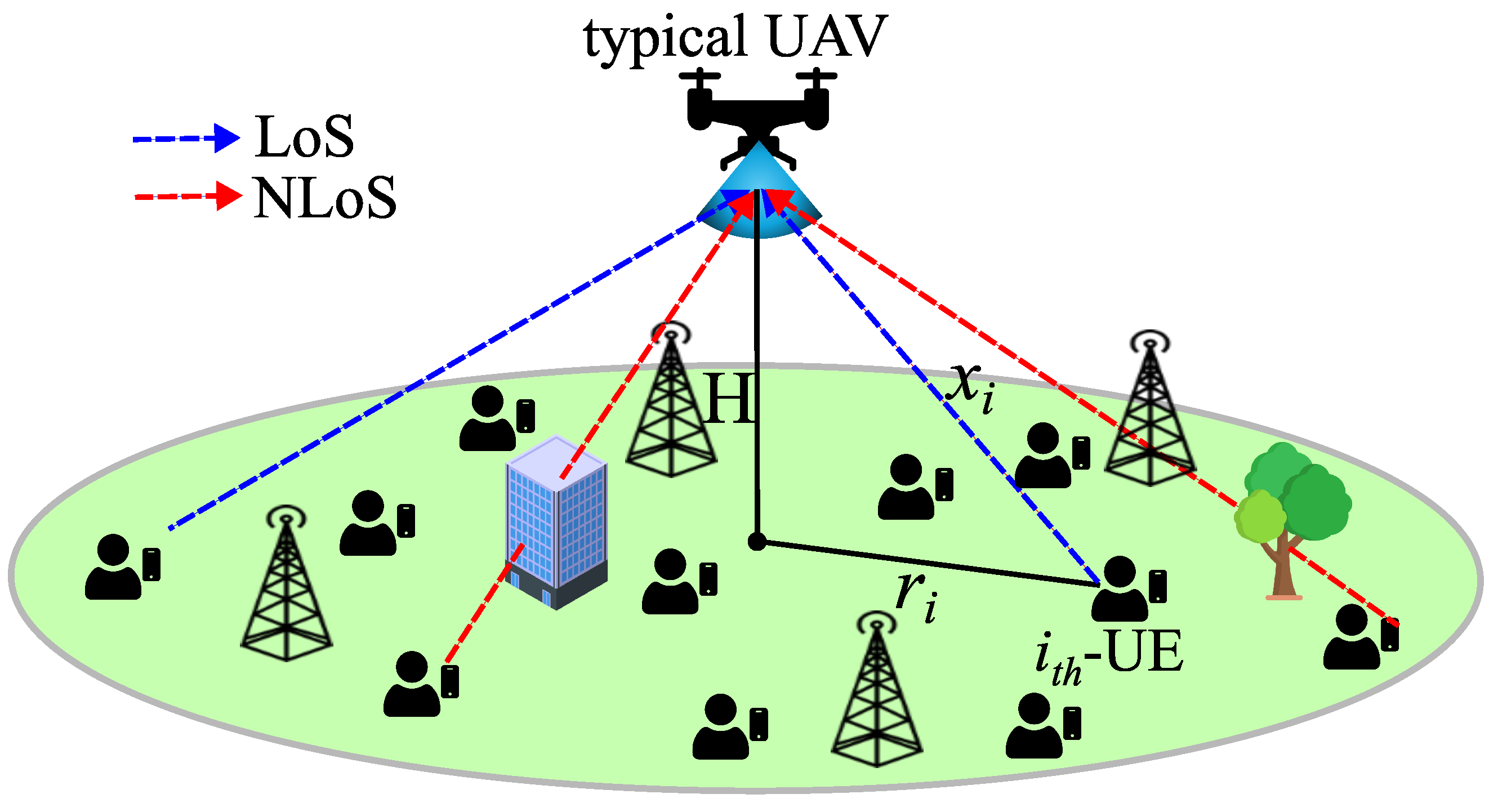
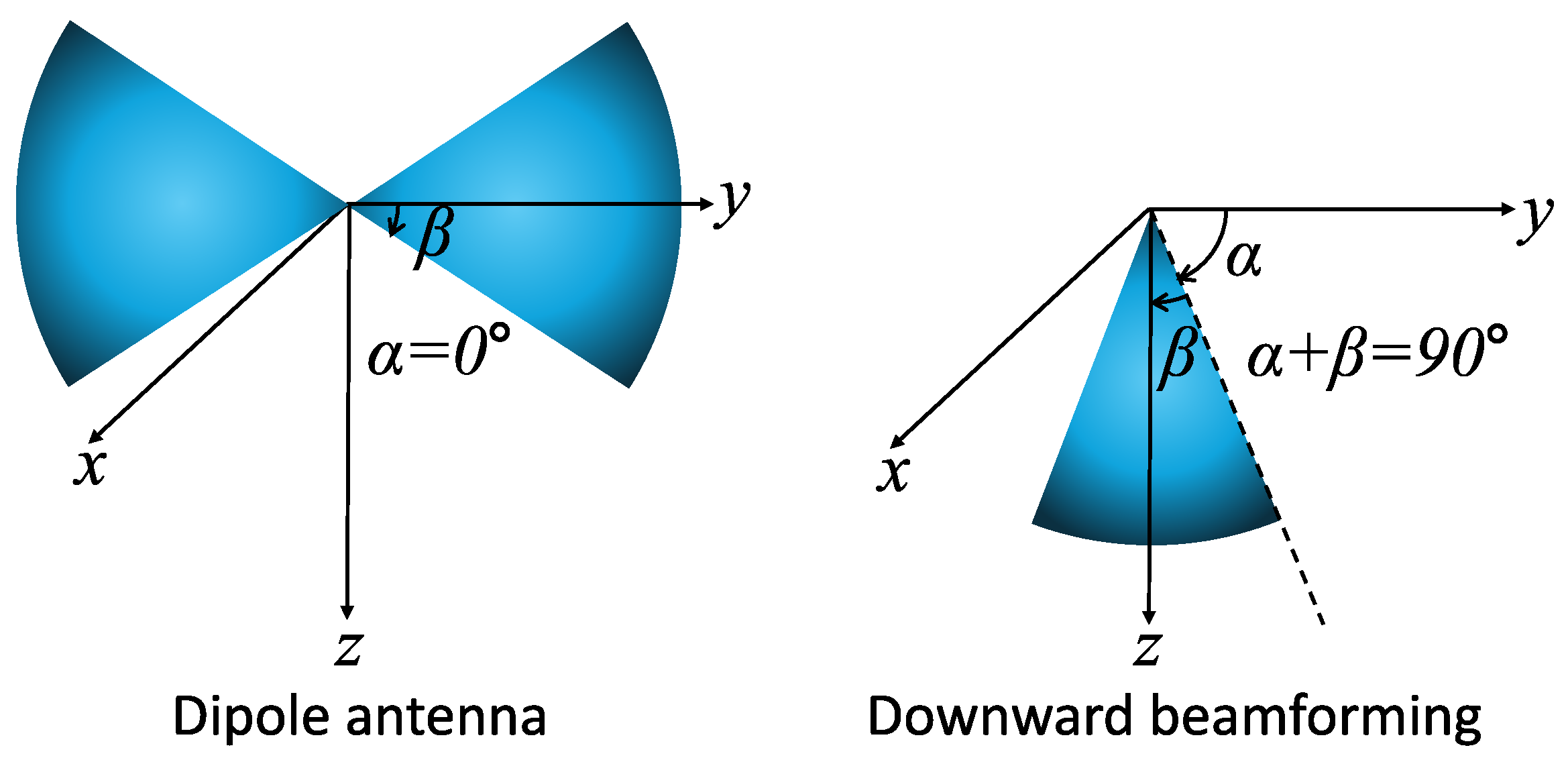
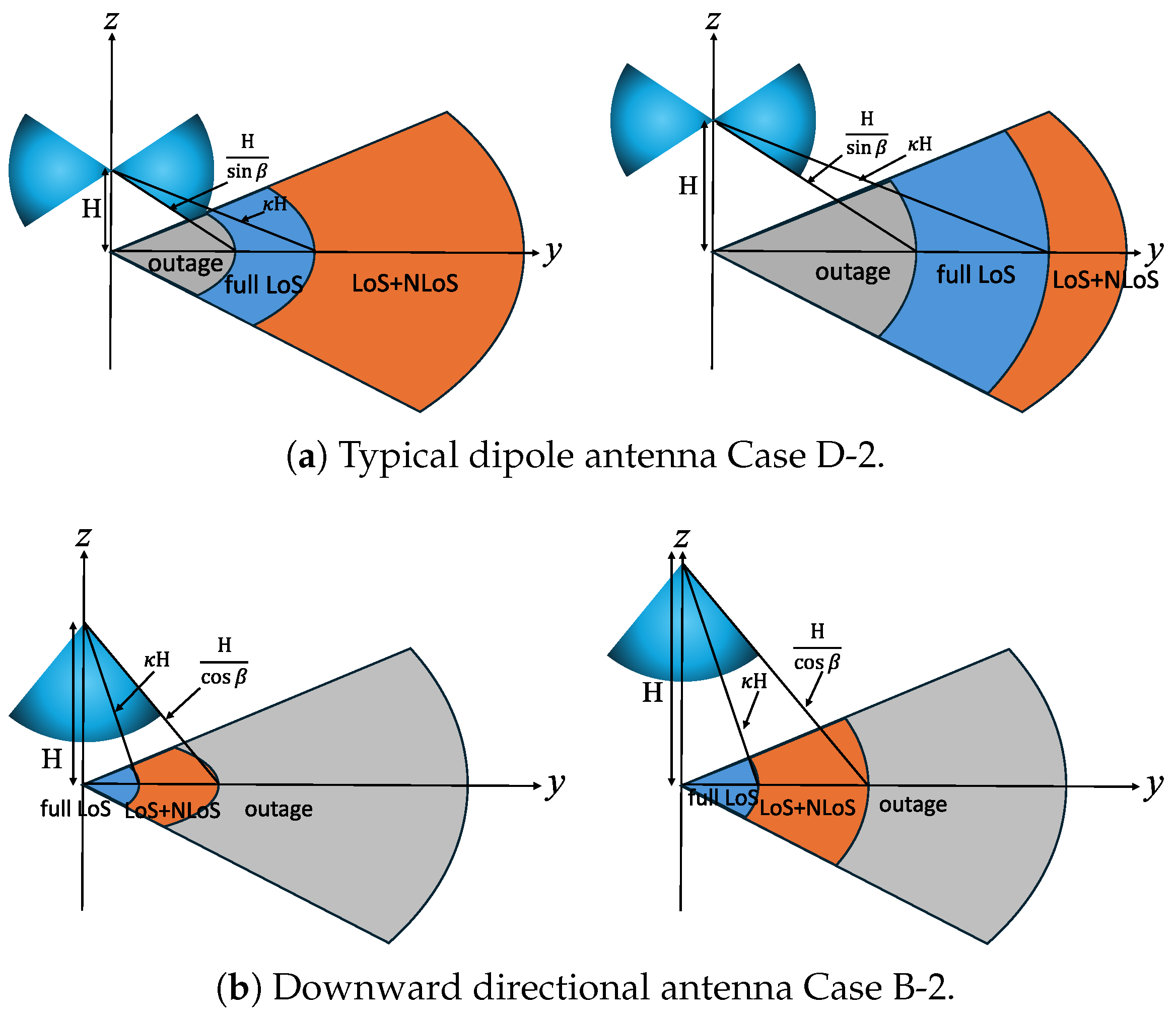
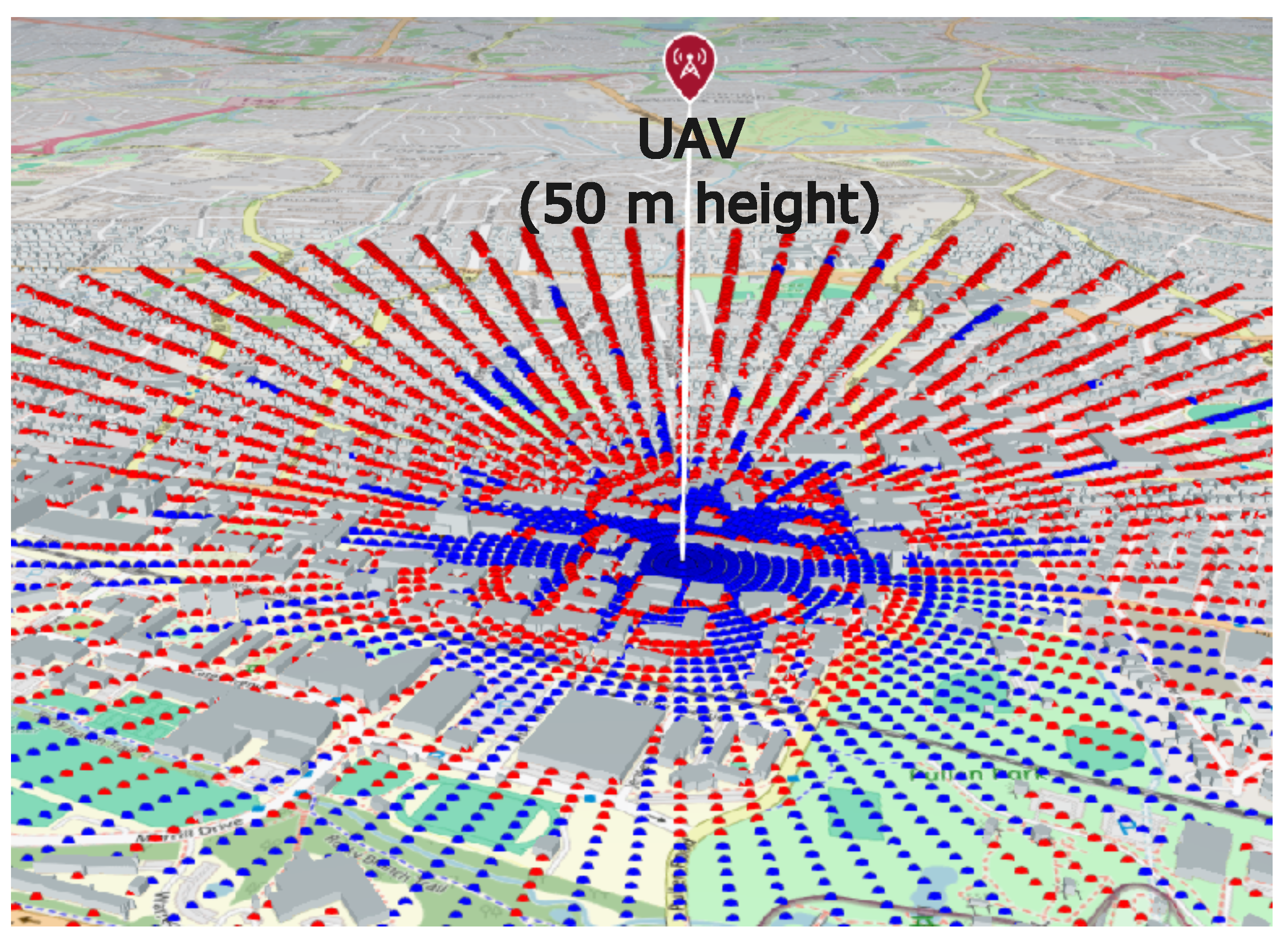

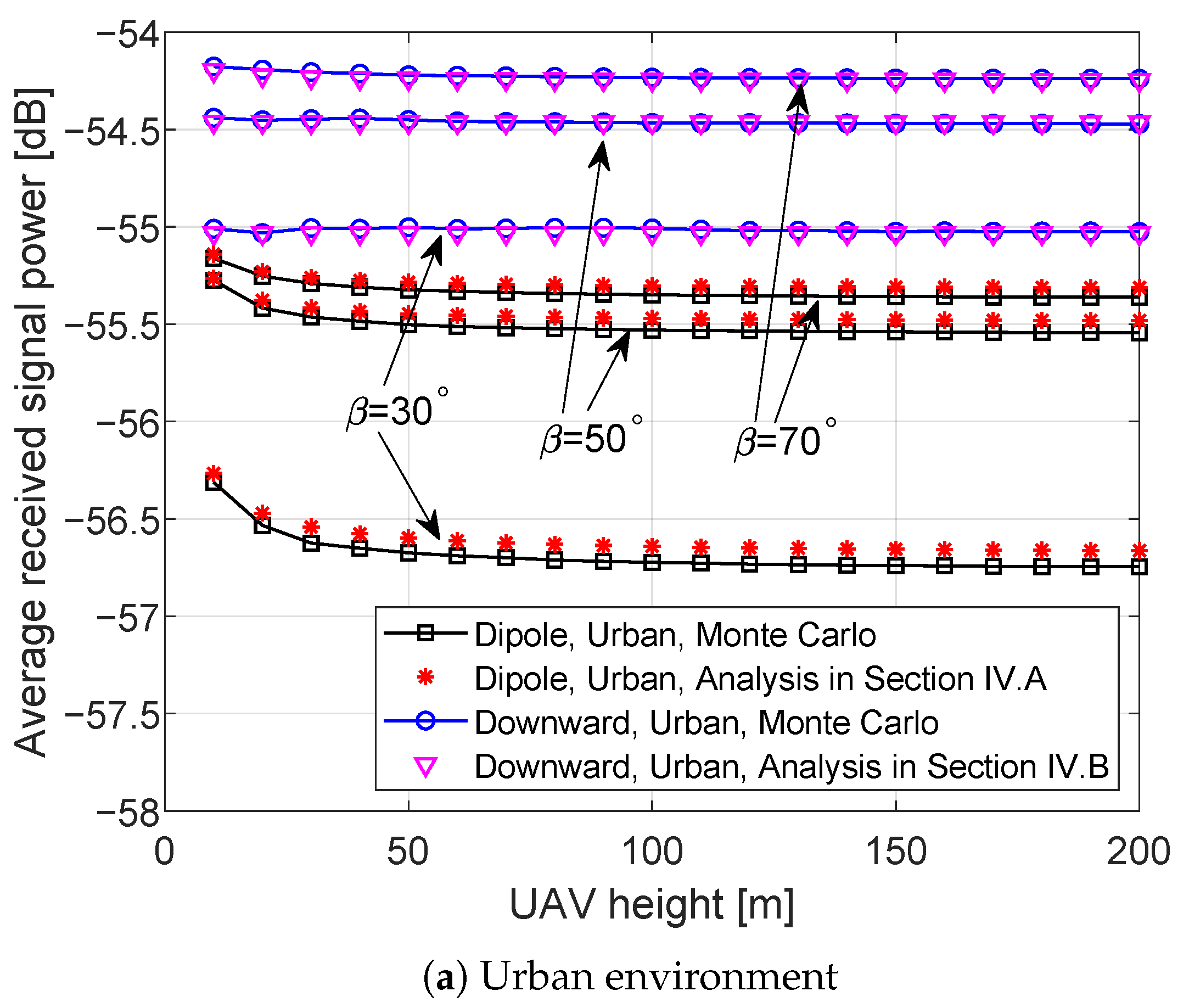
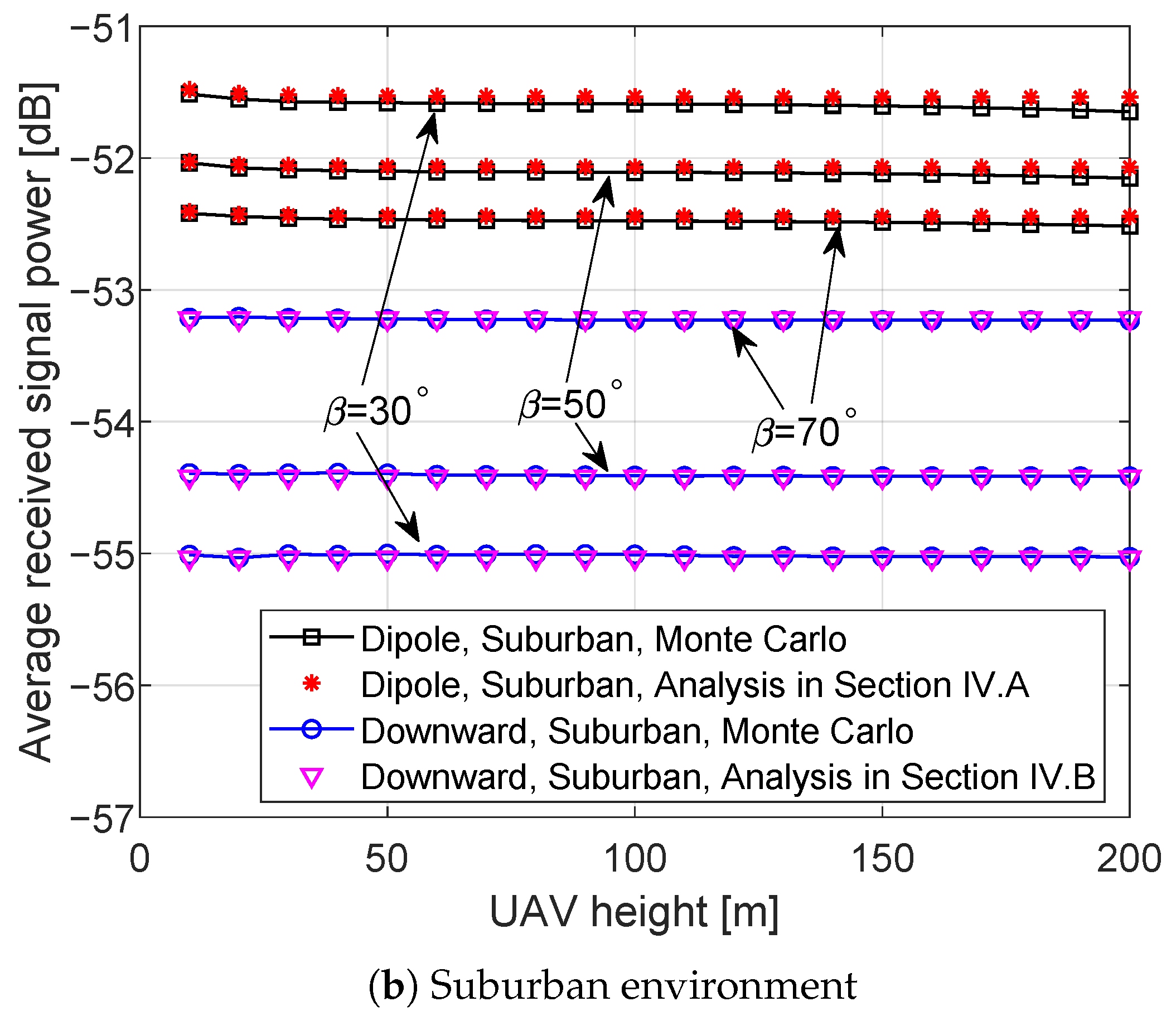
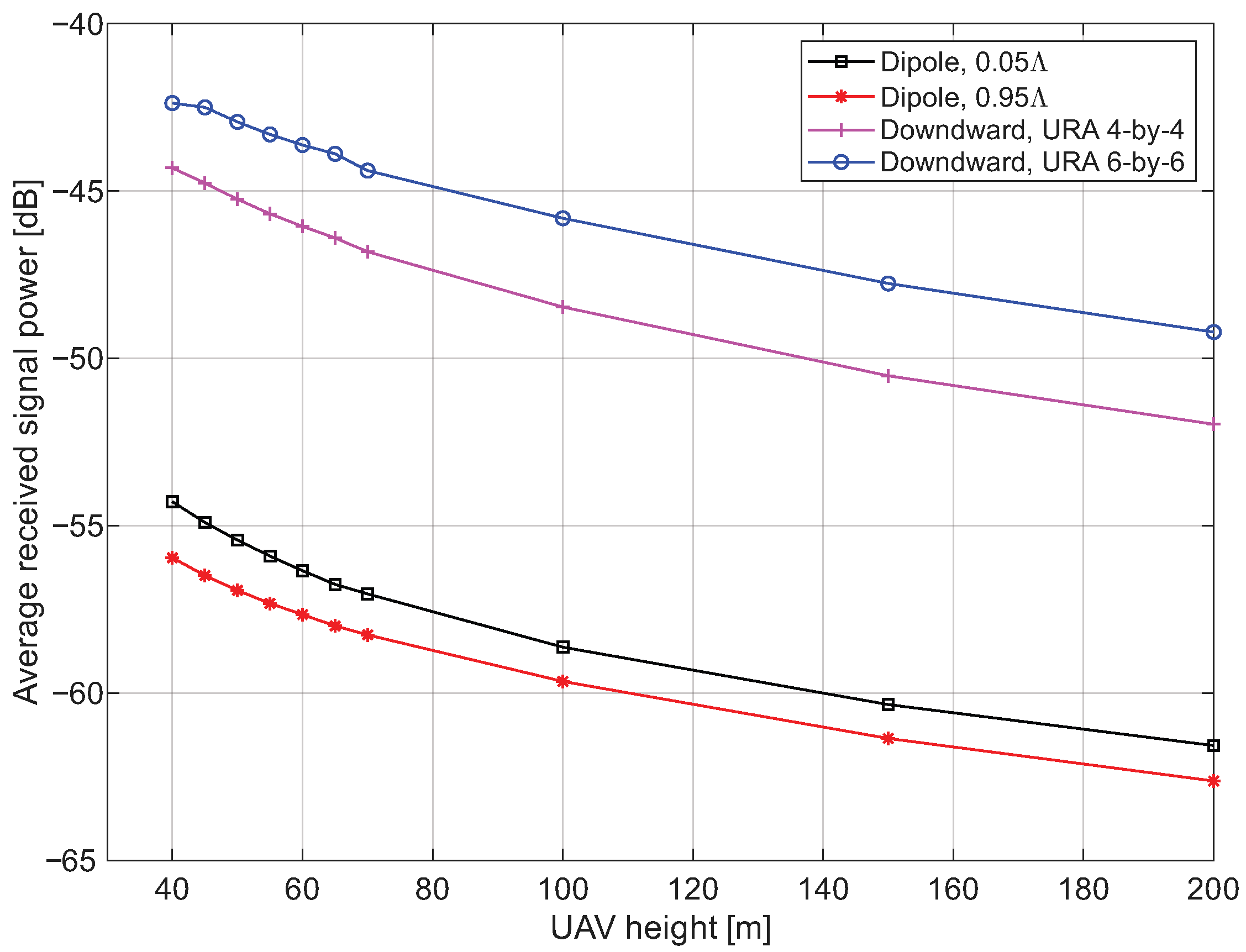
| Ref. | Year | Stochastic Geometry | Ray Tracing | Measurement Campaign | 3D Antenna Pattern Analysis | LoS Probability | Metric |
|---|---|---|---|---|---|---|---|
| [13] | 2016 | ✓ | ✗ | ✗ | ✗ | ✗ | coverage probability |
| [10] | 2018 | ✓ | ✗ | ✗ | ✗ | ✓ | aggregate signal power |
| [12] | 2023 | ✓ | ✗ | ✗ | ✗ | ✗ | coverage probability |
| [14] | 2025 | ✗ | ✗ | ✓ | ✗ | ✗ | aggregate signal power |
| [16] | 2025 | ✓ | ✓ | ✓ | ✗ | ✓ | aggregate signal power |
| This work | – | ✓ | ✓ | ✗ | ✓ | ✓ | aggregate signal power |
| Antenna Type | Beamwidth () | Environment () | Exact Condition | |
|---|---|---|---|---|
| Case D-1 | dipole | relatively narrow with fixed environment | relatively suburban with fixed beamwidth | |
| Case D-2 | dipole | relatively wide with fixed environment | relatively urban with fixed beamwidth | |
| Case B-1 | downward directional | relatively narrow with fixed environment | relatively urban with fixed beamwidth | |
| Case B-2 | downward directional | relatively wide with fixed environment | relatively suburban with fixed beamwidth |
| Parameter | Value |
|---|---|
| Transmit power (Pt) | 20 dBm |
| Transmitter antenna gain (Gt) | 10 dBi |
| Receiver antenna beamwidth (β) | [30, 50, 70]° |
| Node density of UEs (λ) | 0.005 nodes/m2 |
| Pathloss exponent of LoS (ηlos) | 2 |
| Pathloss exponent of NLoS (ηnlos) | 3 |
| Environments | Urban, suburban |
| Carrier frequency () | GHz |
Disclaimer/Publisher’s Note: The statements, opinions and data contained in all publications are solely those of the individual author(s) and contributor(s) and not of MDPI and/or the editor(s). MDPI and/or the editor(s) disclaim responsibility for any injury to people or property resulting from any ideas, methods, instructions or products referred to in the content. |
© 2025 by the author. Licensee MDPI, Basel, Switzerland. This article is an open access article distributed under the terms and conditions of the Creative Commons Attribution (CC BY) license (https://creativecommons.org/licenses/by/4.0/).
Share and Cite
Maeng, S.J. Height-Dependent Analysis of UAV Spectrum Occupancy for Cellular Systems Considering 3D Antenna Patterns. Drones 2025, 9, 821. https://doi.org/10.3390/drones9120821
Maeng SJ. Height-Dependent Analysis of UAV Spectrum Occupancy for Cellular Systems Considering 3D Antenna Patterns. Drones. 2025; 9(12):821. https://doi.org/10.3390/drones9120821
Chicago/Turabian StyleMaeng, Sung Joon. 2025. "Height-Dependent Analysis of UAV Spectrum Occupancy for Cellular Systems Considering 3D Antenna Patterns" Drones 9, no. 12: 821. https://doi.org/10.3390/drones9120821
APA StyleMaeng, S. J. (2025). Height-Dependent Analysis of UAV Spectrum Occupancy for Cellular Systems Considering 3D Antenna Patterns. Drones, 9(12), 821. https://doi.org/10.3390/drones9120821










